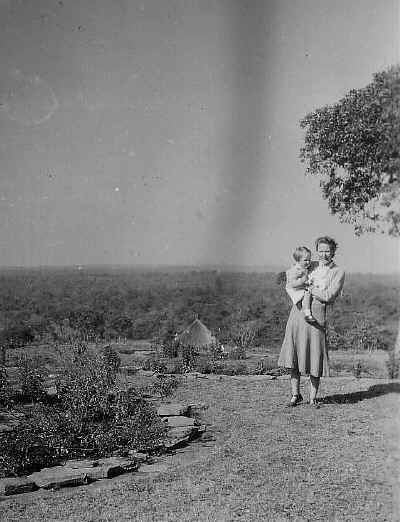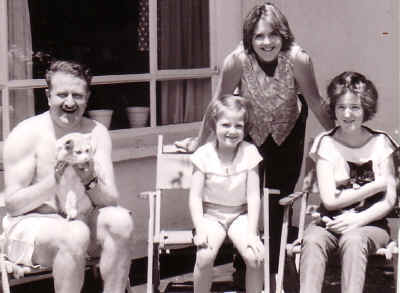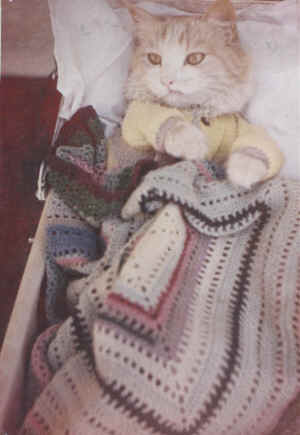| Richard (Tim) Dening married Elisabeth Beadle in
Luanshya, Northern Rhodesia on March 5th, 1949. Elisabeth (Betty) had trained as a nurse
in Bristol, England during the war. Seeking a more adventurous life (which she certainly
found!) she had taken up a job in Africa after the war ended. They
first met in 1947 on the train which took them both from Capetown, South Africa ( where
the boat journey from England ended) all the way up to Northern Rhodesia. Betty was to
work as a nurse on the Mine hospital on the Copperbelt.
(Advice for Colonial
Officers on Boat Disembarkation Procedures is reproduced here.)
They did not immediately strike up a relationship, but renewed
their acquaintance some time later, while Tim was working in Ndola District. They married
after a relatively short courtship and not long after, went to live in Mwinilunga in the
north-west of Northern Rhodesia.
Tim became District Commissioner in Mwinilunga in
October 1949. They lived there for five years, during which time their daughters,
Katherine (Kate) and Clare were born.
 |
They were in the heart of the
bush, with few other European neighbours or recreational outlets. It was here that Tim
resumed his childhood hobby of butterfly collecting in earnest. Twice a year he would visit all the villages in his District, in his D.C.'s
role. He would hear appeals from the local courts, sort out complaints and land disputes
and ensure the payment of tax to the local chiefly authorities, amongst other tasks.
Betty would sometimes accompany him, with Kate carried in a meat
safe by bearers! Initially, they used bicycles as their main means of transport.
They had no European neighbours, so by the time they left for leave
in Cambridge in 1954, Kate was fluent in Lunda, as well as English. |
After Mwinilunga, Tim was in charge of two further
Districts, Mumbwa and Samfya. His daughter Barbara were born in this period, before Tim
moved into central government in Lusaka in 1959. The family lived there until finally
leaving Zambia in 1971.
 |
 |
| Cats continued to be a
Dening family tradition. Tibby, a beautiful honey-coloured Persian was Tim's favourite.
This daft cat would allow the children to dress him in doll's clothes and would then lay
on his back in a doll's pram, happily holding a baby's bottle of milk in his paws and
sucking from it! |
Family holidays were often at Siavonga, on Lake
Kariba, which was created by the building of the massive Kariba hydroelectric dam. These were
idyllic times of sun and water sports. The family would swim and soak up the sun, while Tim
caught butterflies.
After Zambia, the family went to live in Malawi for
three years, leaving Kate behind. By this stage, Kate was following in her mother's
footsteps and was working as a nurse on the mine hospital in Luanshya, while Clare and
Barbara were both at boarding school in England. Tim and Betty initially lived in Zomba,
before relocating to the newly built capital city, Lilongwe for the remainder of their
stay.
At the end of Tim's contract in Malawi, they returned to base
themselves in England. Tim took up consultancy jobs in his role as an agricultural
economist and continued to travel widely. Betty accompanied him on the longer assignments.
She used her considerable resourcefulness to make living conditions bearable for them both
in countries with minimal resources such as Tanzania and Somalia.
They spent three years in Sri Lanka, living in Colombo, before
driving back to the UK in the Austin Allegro estate car which they had imported with them
three years previously. Betty's diary of this great adventure can be accessed here.
Kate, Clare and Barbara had all got married by this time. Kate
married Steve Brown, a Hong Kong Policeman and went to live in Hong Kong. Barbara joined
her some years later, through also marrying a Hong Kong Policeman, Matt Corker, after an
extended visit to stay with Kate and Steve. Clare married Robert Halliday, who was in the
military, based in the UK and Germany.
Tim and Betty retired to the south coast of England,
where Tim finally had time to concentrate on his butterfly collection. He spent many years
working on the production of a checklist of Zambian butterflies, as well as writing
articles on a wide variety of subjects, including BSE, nutrition and politics, all of
which he was passionately interested in.
Tributes
|

